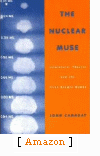|
|
A stunning examination of the ways in which science resorts to literary devices to describe its observations of nature. Taking the development of the Bomb as his example, Canaday also shows how those same devices helped its makers to deal with the moral and human consequences of their actions.
Nicholas Clifford, [ more comments ] |
|||||||||||||||||||||
|
Contents
|
Reviews & Essays S. S. Schweber, Annals of Science John Canaday's beautifully written and insightful study, The Nuclear Muse, is the melding of literature and science at its best. He wants to understand how the nuclear physicists, who working at Chicago and at Los Alamos made nuclear weapons a reality, were inspired by their readings before World War II. He probes how and why they used metaphors, analogies, and tropes to obtain insights into, and to come to terms with, the representations of the dynamics of the microscopic world that they had created, and why, during and after the war, they adopted literary modes of expression to come to terms with, and to explain, the new world they had shaped.
[ more ]
David Kirby, The San Francisco Chronicle . . . a brilliant study of the interplay between literature and physics. John Canaday writes that the young physicists had turned to the story about a man who attained supernatural powers by selling his soul to the devil to acquire "the metaphorical tools with which both to explore and to contain the disruptions involved in this dramatic leap in their search for a deep knowledge of nature."
[ more ]
Canaday's positioning of The Nuclear Muse as a book-length 'experiment' in the application of literary theory to scientific texts is not a naïve attempt to win converts from the scientific community, but instead reflects the author's philosophy that literary critics and science studies scholars must self-consciously state their objectives and assumptions if they are to win the respect of the entire scholarly community (including scientists).
[ more ]
| |||||||||||||||||||||

|
|
|
|




